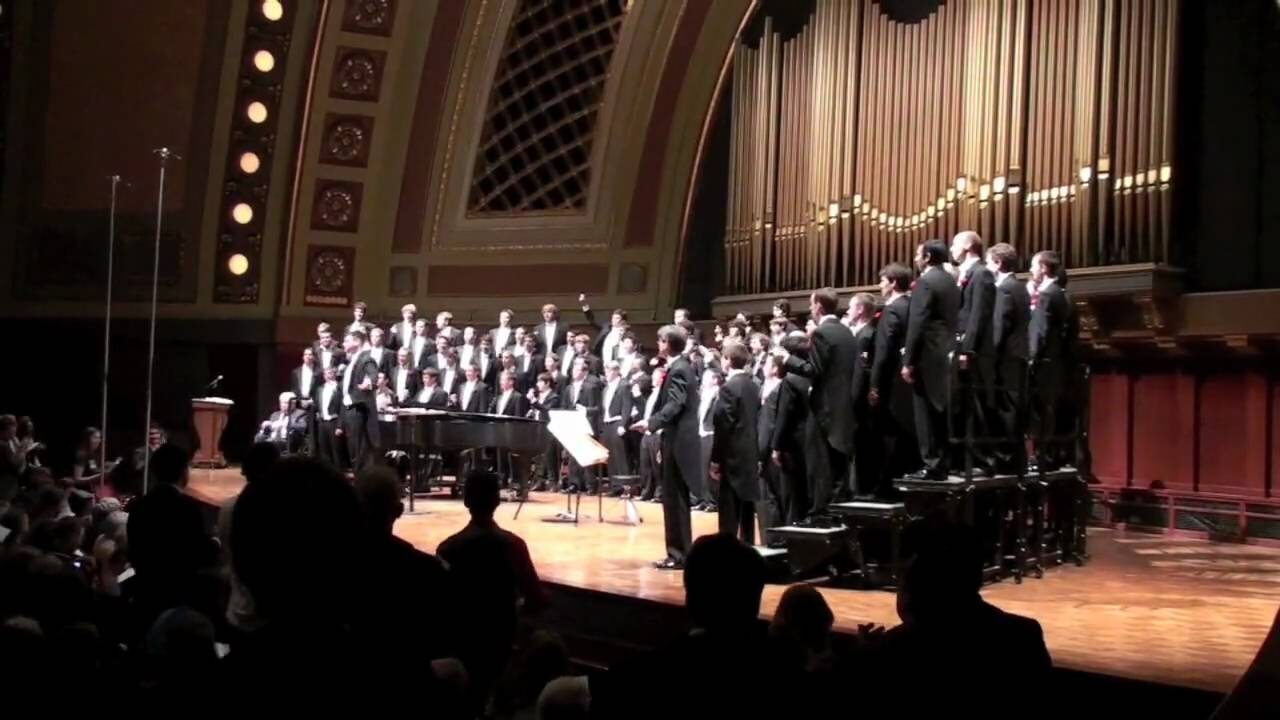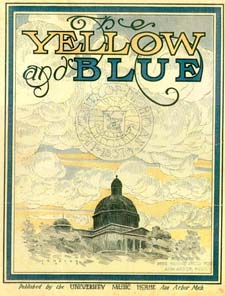How a $20 prize inspired Michigan’s alma mater
In the mid-1880s, the student editors of the University of Michigan Palladium,forerunner of the Ensian,announced a contest.
It was time, they said, for Michigan to have an official alma mater,a song of loyalty and love to rival Yale’s tearjerking “Bright College Years.” They offered a prize of $20 for the winning entry, $5 to the runner-up.
Two young friends, both of them instructors in the literary department (forerunner of the College of Literature, Science, and the Arts), took up the challenge.
One was Fred Newton Scott, barely out of U-M and now an instructor in English composition. Scott imagined a song to be sung by pals in an Ann Arbor saloon. He scratched out lyrics to a drinking song he titled “Elixir Juveniatis” (“Elixir of Youth”). Its boisterous chorus went like this:
Here’s health! Clink-clink! Here’s wealth! Clink-clink!
As much as we can spend!
Here’s a wife! Clink-clink! Long life! Clink-clink!
And weal to every friend!
True colors
Meanwhile, Scott’s friend, Charles Mills Gayley, 27, was in a more contemplative mood. As he wrote the lyrics of his own entry, he was thinking of the school colors—”azure blue and maize,” chosen by a committee of students in 1867—and the look of farmers’ fields around Ann Arbor at harvest time.
Gayley was the son of a Scotch-Irish Presbyterian missionary and a mother whose New England roots went back to the Mayflower. After his father died in China when Gayley was only five, his mother married an Irish parson who taught the boy to love Latin and English literature. In school he was guided toward a career in the British clergy. But he was an American by birth and, when he was 17, his great uncle, a prominent attorney in Ann Arbor, brought the bright youngster home to be educated at U-M.
In off hours at Michigan he boxed, rowed, and took long walks on the banks of the Huron, while in Latin and English he became a star. After his graduation in 1878, then two years as a school principal in Muskegon, he returned to Ann Arbor to teach. By 1884 he was an assistant professor of Latin, highly popular among students and much approved by his superiors.
“Hail to the colors we wear”
When Gayley saw the songwriting challenge in the Palladium,he “decided first upon the conception and image to be expressed in the song,” as he later recalled. Next he chose a melody—a soft, wistful air called “Pirates’ Chorus” from The Enchantress, an opera by the Irish composer Michael William Balfe. Then, line by line, he composed his lyrics.
They were a paean to the color and light of late summer in Michigan—the yellow grain in the fields, the yellow harvest moon, the varying blues of the sky at morning and sunset. These “ribbons that nature has spun” reminded him, too, of “the maid of the golden hair, and eyes that are brimming with blue.”
For his final refrain, long before Louis Elbel chose the word that famously launches “The Victors,” Gayley wrote: “Hail to the college whose colors we wear. Hurrah for the yellow and blue!”
Against this effort, Fred Scott’s “clink-clink” stood little chance. Gayley took first prize—Scott earned $5 for second place—and the words were published in the Palladium of 1886.
It might have ended there. But students loved the song and began to sing it. Leaflets with the words were printed, and within a few years it was, indeed, the University’s recognized alma mater.
The song remains the same
Gayley’s little sister Sara had remained at home in Ireland. Many years later, long after she had moved to Ann Arbor herself and married Shirley W. Smith, who became Secretary of the University, Sara remembered her brother singing “The Yellow and Blue” on visits home.
“As I often nowadays see and hear the song sung by thousands of loyal Michigan men, bareheaded at football games, in our great stadium,” she wrote, “my mind goes back to the first time I heard it in our little parlor … and I see myself as an adoring little sister full of pride in her brother, asking him how he ever came to write such a wonderful song, and hearing his hearty laugh as he answered, ‘Well! I needed the $10!'” (Sara misremembered; it was $20.)
In 1889, at the age of only 31, Gayley was recruited to head the Department of English Language and Literature at the University of California at Berkeley (which doubled his Michigan salary), and he became one of the great English scholars of his generation.
Gayley returned to Ann Arbor from time to time. In 1925, near the end of a long life, he wrote: “It has always been a great joy to me, revisiting Ann Arbor, to hear the song still sung in fraternity houses, and on the campus in the twilight … I have heard it in mid-ocean, on the streets of Florence and Rome, and hither and yon as I have traveled about the world. A song written in the days of one’s youth, if it by good luck expresses the emotion and enthusiasm of succeeding generations of young men and women, is a thousand times more worthwhile than many books of learning.”
Sources included Benjamin R. Kurtz, Charles Mills Gayley (University of California Press, 1943).






Phillip Rogers - 1975
I find it odd that the article doesn’t include the finshed lyrics.
Reply
Owen V Johnson - 1970, 1978
Was not Fred Newton Scott also the first journalism teacher at Michigan?
Reply
Deborah Holdship
Sorry for the confusion re: lyrics for “The Yellow and Blue.” The lyrics can be seen in the PDF of the sheet music, linked near the end of the article. The link now reads: “Sheet music and lyrics for ‘The Yellow and Blue.'” — Editor
Reply
Deborah Holdship
Re: The comment about Fred Newton Scott — The following note comes from the U-M Bentley Historical Library archives: “As early as 1890-91 [Fred Newton Scott] had offered a course in ‘Rapid Writing.’ This developed into Course 13, ‘Newspaper Writing; Theory and Practice,’ offered in the new department, and marks the beginning of the study of journalism at the University of Michigan and in the nation. Under his leadership the department became a leader in the teaching of creative writing, journalism, and criticism.” Thanks for pointing it out. — Editor
Reply
Phillip Rogers
Thanks so very much for the lyrics. Many of us had never seen the 2nd and 3rd verse. Even in the MMB I think we only sang the 1st! Phil Rogers, Michigan Undergrad ’67-’75
Reply
Stephen Qua
Wonderful story and all true. Sara and Shirley Wheeler Smith were my Great Grandparents.
One funny story about that song… As you might imagine, it has been heard/sung in our house many, many times while I was growing up. We were taught the words at an early age along with a rowdy GO BLUE and the words to The Victors.
My brother Brad (’83) was sitting in his seat at a football game when the band struck the first notes of the introduction. The poor son of a gun sitting next to him suggested that they didn’t need “that hail song because nobody knows the words”. Not only did he receive a strong rebuke from Brad that some of us not only know the words but have a personal relationship with that song, he proved it by singing VERY loud.
Hurrah for the Yellow and Blue.
Reply
Brad Qua - 1985
Hail!
Reply
Pat Mullahy - '83 B.A., economics
I often hum the words of The Yellow and Blue to myself on my postal route. It sure does pass the time in a good way!!
Reply
Chris Campbell
During my time at U-M in the early 1970s, it wasn’t fashionable to be sentimental, and in that respect I was a fashionable guy. But I’d listen to WUOM late at night and when it signed off at midnight, it would play “The Yellow and Blue.” In that way the song insinuated its way into my memory. Now I cannot hear it without getting moist eyes because it puts me in mind of that astonishing institution in Ann Arbor that is our state’s finest gift to the world. By the way, Mr. Tobin could probably write an article about the Burger King menu and make it interesting. He’s a prize. I look forward to his Roosevelt book.
Reply
Edward Gallagher
Gayley went to Berkeley to become English Dept. Head. He wrote Cal’s alma mater too! Gayley took a young UM instructor (with Michigan degrees) with him to Berkeley. Alexis Lange became the “father” of both the junior college and the junior high school. I am writing a book on this topic, having published numerous articles on the junior college. Thank you, Dr Tobin, for your interesting article.
Reply
Terence Martin - 1983
Awesome song, but it’s a darn shame that it seems the only groups that actually know the words are the Glee Club and the Marching Band. Somehow the students think it cool to just wait and scream “Hail!” but in fact, it makes us look like idiots.
Reply
James Mercier
I’ve never heard anyone (outside of possibly the Glee Club) sing the 2nd and 3rd verses. Do we not sing them because they might be considered a little politically incorrect? (I’m thinking of the “Here’s to the maid of the golden hair and eyes that are brimming with blue” line.) The problem with only singing the first verse is that it only talks about yellow, and not the blue.
Reply
Steve Frenkel
I thought that our Alma Mater was sung in Latin to entirely different music. All my recordings of the Men’s Glee Club feature it as the Alma Mater. When did this change?
Reply
James Tobin
James Tobin writes: Thanks for your query, Steve. “The Yellow and Blue” is indeed regarded as U-M’s alma mater. I bet you are thinking of the lovely Michigan song “Laudes atque Carmina,” the lyrics of which Charles Gayley also wrote. (Albert Stanley, a U-M professor of music, composed the piece.)
Here’s a link to many Michigan song lyrics at the website of the Men’s Glee Club.
(http://ummgc.org/about/lyrics).
And here’s a video of the U-M Harmonettes, an a capella ensemble, singing the famous first verse of “The Yellow and Blue.” (http://www.youtube.com/watch?v=dYB4kzMgWHI)
Reply
Aipu Dragos
Interesting things in this article. Good job
Reply
JONATHAN SILVER - Yale,'69
Imitation is the sincerest form of flattery, but humility may be second: Why does “The Victors” conclude that Michigan is merely “The champions of THE WEST”?
Reply
Mark Majoros - 1980
Regarding “The Victors” fight song.
Louis Elbel wrote the song following Michigan’s victory (completing an undefeated season, by the way) over University of Chicago to win the Western Conference championship. Hence, “Champions of the West”.
Reply
Susan Smith - AMLS '80
When I was a grad student at the U of M one of the college supply stores sold a tee shirt with the lyrics of “The Yellow and Blue” – upside down, so it could be read/sung by the wearer!
Reply
Jessica Rickert - 1975
How can I obtain flute music for the entire song, “The Yellow & Blue?”
Reply
Deborah Holdship
I suggest you reach out to Amy Porter — akporter@umich.edu. She let me know she has it in the University of Michigan Songbook, compiled by Rosalie Edwards. It’s the score. “If you play from the score on the flute, you’d follow the soprano line,” she says. Good luck!
Reply
Pete Larson - 88 Architecture
It’s written as “harvest wain.” Why not “harvest wane?”
Reply
Deborah Holdship
Hi, Pete! Wain is the word for “wagon.” Hope all is well! Deborah
Reply